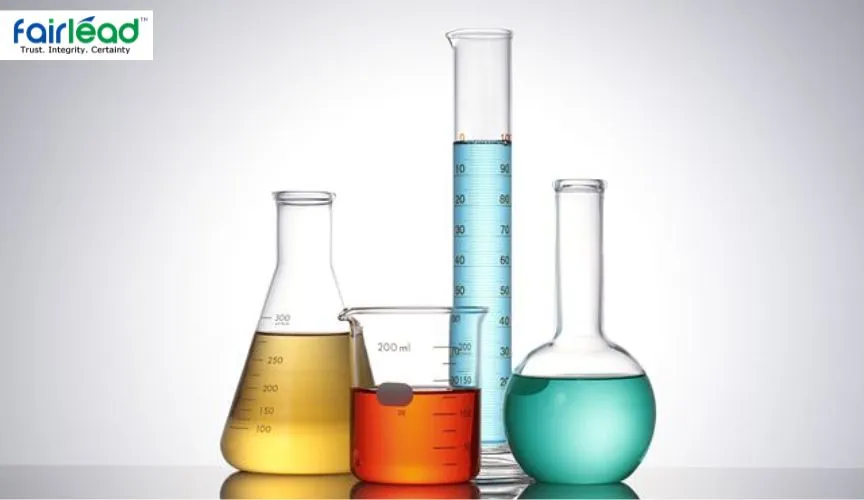By guaranteeing the quality, safety, and compliance of goods and materials, chemical testing laboratories play a significant role in a variety of industries, from manufacturing to medicines. The study accesses the chemical properties of substances using a wide range of cutting-edge techniques and equipment.
We will delve into the numerous kinds of chemical testing carried out by these facilities in this extensive blog, illuminating their importance and applications.
Eight Types of Chemical Testing Done in a Laboratory
To understand the complex properties of substances, a wide range of chemical testing procedures are used in a laboratory context. The foundation of knowledge, safety, and innovation in the chemical landscape is collectively strengthened through these interconnected testing domains.
Composition Analysis
The analysis determines the substance's molecular and elemental makeup. Composition testing is required to ensure the authenticity of raw materials and final goods.
In the identification and quantification of components of a sample, techniques such as mass spectrometry, chromatography, and spectroscopy are regularly utilized. Composition analysis, which is used in the pharmaceutical business, ensures the uniformity of active substances in medicines.
Contaminant Detection
Contaminants tend to have a negative impact on the quality and safety of things. In chemical testing laboratory, modern procedures are utilized to identify contaminants.
There are varied contaminants such as heavy metals, pesticides, and microbiological agents in a variety of materials. The test is carried out for ensuring that food, beverages, and consumer items comply with standards and do not endanger consumers' health.
Material Identification
Identifying a material includes figuring out what kind of substance it is. When the validity or origin of a piece of content is in doubt, this testing is crucial. Materials can be recognized based on their distinctive molecular or crystal structures using methods like Fourier-transform infrared spectroscopy (FTIR) and X-ray diffraction (XRD).
Purity Assessment
A substance's purity is determined by assessing the amount of contaminants it contains. Impurities with high concentrations might reduce a product's quality and effectiveness.
Titration, gas chromatography, and high-performance liquid chromatography (HPLC) are methods used in chemical testing laboratory to measure impurities and make sure items adhere to predetermined purity requirements.
Chemical Reaction Analysis
Analysis of chemical reactions entails seeing how various compounds behave. For understanding reaction mechanisms, enhancing reaction conditions, and creating new chemical processes, testing is essential.
To track reactions and examine reaction kinetics, laboratories use methods like nuclear magnetic resonance (NMR) spectroscopy and calorimetry.
Stability Testing
This test examines how different environmental settings impact a material or product over time. For assessing shelf life, storage needs, and packaging issues, this kind of testing is essential.
In order to predict how samples may deteriorate over time, chemical testing labs subject samples to a range of variables, including those linked to temperature, humidity, and light.
Toxicity and Safety Testing
The toxicity and safety testing determines the possible dangers that chemicals and materials pose to the environment and living. Verification of the test qualifies that objects and materials are safe and will not endanger ecosystems or public health.
In testing for potential risks of substances, laboratories conduct acute toxicity, genotoxicity, and ecotoxicity testing.
Environmental Analysis
Environmental analysis' major purpose is to investigate how substances affect the environment. The testing looks for pollutants, contaminants, and dangerous substances in environmental elements such as air, water, soil, and sediment samples. These tests are crucial for environmental monitoring, pollutant management, and rule enforcement.
Chemical testing facilities are crucial for ensuring the quality, compliance, and safety of items and materials used in a variety of industries. The procedure includes a complete environmental investigation, testing for toxicity and safety, identifying materials, analyzing purity, checking for impurities, stability testing, examining chemical reactions, and examining their composition.
Conclusion
These labs offer priceless insights that spur innovation, safeguard the public's health, and preserve the environment. Chemical testing procedures will change as technology develops, allowing these labs to meet new problems and contribute to a safer and more sustainable world.
The core competency of Fairlead, material identification, demonstrates their prowess in solving the mysteries of unidentified substances, boosting industries' trust in the legitimacy and origin of their commodities. The meticulousness with which Fairlead Inspection evaluates purity not only ensures the consistency of the materials but also highlights their function as stewards of quality in a cutthroat market environment.
In the fields of chemical reaction analysis, stability testing, and toxicity evaluation, Fairlead Inspection's expertise not only promotes research and development but also serves as a safeguard against potential dangers. Through thorough pollutant detection and environmental effect assessment, Fairlead Inspection's environmental analysis actively contributes to the protection of our planet, echoing its philosophy of responsibility.
Fairlead Inspection - The Most Reliable Chemical Testing Laboratory
In a world where quality, safety, and compliance are paramount, Fairlead Inspection emerges as a beacon of excellence in the realm of chemical testing. As we conclude our exploration of the diverse types of chemical testing conducted by laboratories, it becomes evident that Fairlead Inspection's commitment to precision and innovation sets them apart in this critical industry.
Fairlead Inspection's unwavering dedication to composition analysis ensures that the elemental and molecular makeup of substances is unraveled with unparalleled accuracy. Their adeptness in detecting contaminants ensures that products reaching consumers are not only of the highest quality but are also safe for consumption.
In summary, Fairlead Inspection epitomizes accuracy, dependability, and scientific rigor. Their diverse contributions converge to form a tapestry of brilliance that highlights their responsibility as guardians of the world's well-being as well as elevating industries.
Fairlead Inspection stays at the forefront of scientific development as the world changes, guaranteeing that the goods we use, the medications we take, and the environment we live in are all safe, sustainable, and of the highest caliber. Check out our technologically advanced chemical testing laboratory ensures your product safety and compliance.


